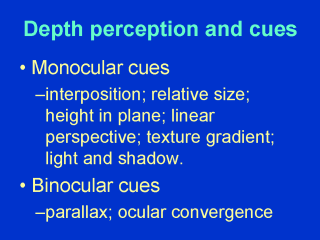 |
Depth perception is important to
primates. All arboreal monkeys and apes need to be able to judge distance very precisely.
For this reason we have two eyes in the front of our heads, offset by about 8cm. This
permits the use of parallax (different views from each eye) and kinesthetic afferent input
from ocular muscles used in ocular convergence as distance cues. But even with one eye
closed, there are a number of stimulus cues which contribute to depth perception. These
include those listed above. Height in plane refers to the horizon being at eye level, and
near objects varying heights above or below the horizon line according to their relative
proximity to the viewer. Texture gradient refers to more detailed textures on closer
objects than more distant ones, while interposition refers to closer objects hiding more
distant objects behind them. Most of these monocular
cues are learned. For example, people who live in an environment of predominantly
“near” objects have problems judging the size of objects when in open country, where a
lack of familiar size cues gives no indication to distance. |
